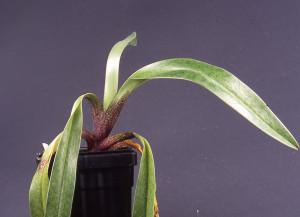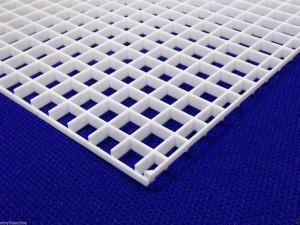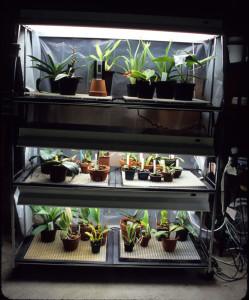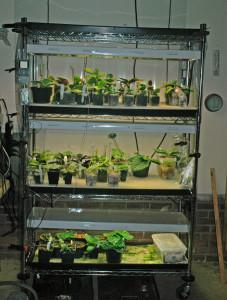MORE ABOUT LIGHT...
Lumens and Foot-candles
There is a lot of confusion between these terms. This quote from Craig Smith on eHow clearly explains the difference between them.
"A 'foot-candle' is a unit of measure for quantifying the intensity of light falling on an object. A "lumen" is a unit of measure for quantifying the amount of light energy emitted by a light source. In other words, foot-candles measure the brightness of the light at the illuminated object, while lumens measure the power of the light radiated by the light source."
The higher the lumen rating of the bulb the brighter it is. See the chart below for comparisons.
4' Linear Fluorescent Bulbs Lumen Output
28 Watt T5 2900 lumens
54 Watt T5 5000 lumens
25 Watt T8 2209 lumens
32 Watt T8 2850-3100 lumens
34 Watt T12 1930-2800 lumens
40 Watt T12 1980-3300 lumens
The relative amount of light a bulb produces for the energy that it consumes used is referred to as luminous efficacy. The higher the value, the more energy efficient the lamp is. The luminous efficacy of T5 lamps is about 100 lm/W, while those of T8 and T12 lamps are about 90 lm/W and 78 lm/W respectively.
The amount of light (lumens) produced is also related to the wattage of the bulbs. There is also some variation within each of these bulb types.
How Much Light is Best?
There are plenty of opinions on how much various orchids need to grow and flower well. One of the problems is that sometimes the recommend foot-candle range is made based on natural light in a greenhouse not under florescent lights. Greenhouse light intensity and color varies dramatically depending on the time of day, cloud cover, and time of year, latitude, etc. Florescent lights provide steady, constant illumination. For that reason, the amount of light intensity, commonly measured in foot-candles with fluorescent lights can be quite a bit lower that that recommended for greenhouse growing.
Florescent lights for growing orchids are usually burned for 12 to 16 hours per day. Obviously this is longer than the average natural day length. The reason for this is that, generally speaking, florescent lights have a lower light intensity that that found by natural light in a greenhouse so to compensate for this lower light intensity the duration of the light is increased.
Modestly priced light meters that are reasonably accurate can be purchased to measure foot-candles. If you decide to get one make sure that is has a reading scale specifically for florescent lights.
Recommended foot-candle range for lower light requiring orchids like slippers and phalaenopsis under florescent lights is from 1000- 1500 foot-candles. This will vary somewhat depending on the types grown. Phragmipediums and hard-leaved paphiopedilums require light intensities on the higher side, while the Maudiae types and most of the other types do fine in the lower range. Other types like cattleyas and oncidiums require higher light intensities. Compact growing orchids, with foliage no higher than 12-15" high are the best candidates for growing under florescent lights since the light intensity from these lamps drops off very quickly as your move further from the lamps. Larger growing orchids are better suited for growing under HID light, which will be discussed later.
Here's some good info on types of orchids and their light requirements:
http://www.orchidplantcare.info/what-is-a-foot-candle/
According to Mr. Bergman in his cited article on his light systems he read 1250 foot-candles 6" from the center 4 tube T-12 strip unit and 780 foot-candles at 12". Since 32 watt T 8's have a similar light output, so these values will be close. These light intensity levels are perfectly suited for slippers (paphiopedilums) and phalaenopsis. Orchid requiring higher light intensities are better off with T5HO (high output) bulbs.
Those orchids requiring the most light should be placed in the center of the tubes. The ones with lower light requirements can be placed on the end of the tubes.
Of course, the real test is how your orchids perform. If the foliage is too dark green and floppy, and the growth habit of the plant is not compact but "leggy", and if the orchids don't bloom on schedule with flowers of good substance and size, then the orchids are not receiving enough light. If this is the case, they should be moved closer to the lights, moved to the center of the tubes, and/or have the duration of the lighting increased.. If the leaves are taking on a yellowish cast, indicating too much light, the plants can be placed further way from or on the ends of the tubes and/or the duration of the lights should be decreased.

Floppy foliage like this indicates insufficient light
Cultural Tips
1. Since the light intensity of under fluorescent lights can be lower than those found in many greenhouse, this can be somewhat compensated for by increasing the duration of light. On average lights can be burned 12-16 hours per day. Some growers vary the length of lighting depending on the natural season---a few hours shorter during the winter and few hours longer during the summer. I have not found this to be necessary, since I have not noticed any of the orchids that I have grown to be sensitive to or to require seasonal light duration changes.
2. The brightest light is under the center of the tubes. Keep this in mind when placing plants with various light requirements.
3. The modest heat from the tubes and ballast may cause a reduction in humidity. This can be an advantage in a cooler location. To conserve heat wrap three sides of the growing area with polyethylene.
4. Muffin fans, available at computer supply stores, are great for creating gentle air circulation around the plants.
5. Plastic light diffusion panels, sometime referred to as egg crate louvres, is a great material to insert in the growing trays under the lights so the plants that are suspended above the water in trays that have been filled with water to increase humidity. They are easy to clean, are available at home supply stores in the lighting section and can be cut with a hacksaw to fit any size growing tray.

6. Replace your lamps every 12 months or so. Don't wait until they burn out to replace them. All of the lamps eventually degrade and start to lose their light intensity. This will be evident by dark rings forming at the ends of the tubes. When this happens you will be using the same amount of electricity to produce less light.
7. Keep the bulbs clean. They can quickly become coated with light reducing dust or sediment from watering.
8. Use ground fault outlets; electricity and water don't mix!
9. In multiple tiered light gardens the temperature can vary 5 degrees F from the top shelve to the bottom one. Keep this in mind when deciding the best spot to place your plants. Maximum-minimum thermometers placed on the shelves are very helpful in determining what this temperature differential is.
Multiple Tiered Light Carts
One of the great advantages of florescent light setups is that they can be stacked in tiers. Commercially made, multiple-tiered light carts are highly versatile, space-efficient, and practical. Most of them are about 2' wide by 4' long so their three shelves provide 24 square feet of growing area.

One of the author's light cart shown above.
Note the plastic egg crate louvering to support the plants above the water filled tray used for increasing humidity. Also the cart is wrapped in plastic to raise humidity and keep in the heat from the ballasts and lamps.
You can also easily fashion your own using metal chrome wire shelving available at any home supply store and suspending whatever light fixtures you choose. This is one I have now in my heated garage that I made from these racks and light fixtures. This rack is 18" wide by 48" long by 6' high. To retain humidity and warmth, I wrapped the back and two sides of the cart with heavy duty clear vinyl that I obtained a fabric store. It works great!

Both of these types of carts will provide enough space to have at least a few orchids in bloom year around. For small growing species, it will provide a convenient growing space that is adequate for an entire collection. You can place the growing structure in a heated garage, in the basement or a spare bedroom.
For some helpful information on making your own multiple tiered light cart see the reference on-line article by Sherri Arnaiz.
Recommendations
I have grown orchids well under all types of lamps and fixtures, so there are many options that work. For those who want to have the flowers appear most naturally colored under the lights and don't mind paying a slight premium for the lamps.
For phalaenopsis, slippers and other lower light requiring orchids I would recommend a four-tube fixture, with a white or mirrored reflector and with an instant start electronic ballast (that will save you electricity and not produce an irritating buzz). Purchase 48", T8, 32 watt lamps or tubes with a Kelvin temperature between 5000 and 5500 (wide spectrum) with a high CRI (in the 90's) with high lumen output.
The most economical and still satisfactory pick is the 50/50 ratio of warm white to cool white lamps. If you have some natural light supplementing these artificial lights this combo will work very well. A compromise in terms of economy and light quality would be a blend of 1/4 warm white, 1/4 cool white and ½ wide or full spectrum lamps.
For those orchids requiring more light use the same setup, but use T5HO (high output) bulbs vs. T8's to give you a higher light output.
References
Bergman, Fred J. 2008.Artificial Lighting Systems. Orchids. 77(2):102-105
Presents a compelling case for the cost effectiveness of growing under florescent lights compared to HID and a greenhouse.
Fitch Charles Marden. 1997. Growing Orchids Under Lights. American Orchid Society.
This booklet is a bit dated but the cultural information is helpful.
Madison Gas and Electric, Light Output Declines with Time
Smith, Craig Foot-Candles Vs. Lumen. , eHow
Wikipedia, Fluorescent-Lamp Formats